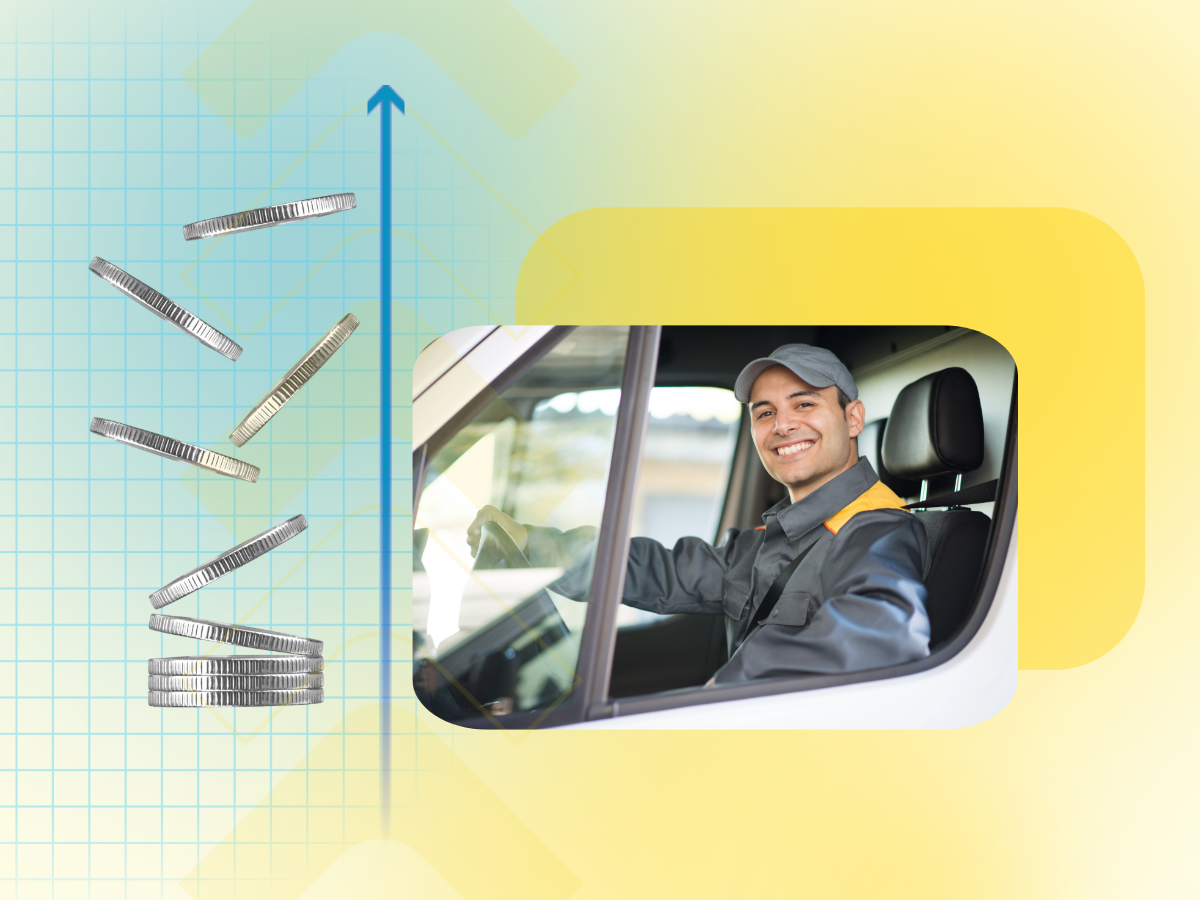Knowing how to price your courier jobs properly is one of the most important parts of running a courier business.
If your quotes are too low, you’ll struggle to cover costs. If they’re too high, you risk losing out to other drivers.
A well-structured pricing strategy ensures you stay profitable, competitive, and attractive to repeat customers.
In this guide, we’ll break down the main factors that influence courier rates, explain how to use industry data to your advantage, and show you how to adapt your pricing strategy for long-term success.
What we’ll cover
Get access to 15,000+ loads a day on Courier Exchange
Be your own boss. Set your own hours. Make your own money.
Understanding the basics of courier job pricing
At its core, pricing courier work comes down to one calculation: price per mile (PPM).
Your PPM is the amount you need to charge for every mile driven in order to cover both fixed and variable costs. To work it out:
- Add up your monthly operating costs (fuel, courier insurance, maintenance, tyres, licences, finance).
- Estimate your average monthly mileage.
- Divide costs by mileage to get your base rate per mile.
This figure is the foundation of your quotes. From there, you can add extras to reflect the job’s requirements, such as distance, location, cargo type, or time of delivery.
Getting this right is especially important for owner-driver courier jobs, where every decision on pricing directly impacts your personal income.
Factors that affect how you price your courier jobs
Several variables influence what you should charge for a delivery.
Understanding these ensures you’re never underpricing your work.
Distance and location
The further you drive, the more fuel you’ll use, and the greater the impact on your vehicle.
But not all mileage is the same. Urban routes involve stop-start driving, while rural jobs often mean longer stretches but with fewer delays.
It’s worth factoring in:
- Return mileage (especially if you’re unlikely to find a backload).
- Road type (motorways are faster but may involve tolls).
- Average delays in specific courier locations.
Longer jobs naturally demand higher courier prices, but don’t forget that shorter urban trips with heavy traffic can also justify a higher rate.
Cargo type, size, and weight
Every load is different, and this should be reflected in your pricing.
- Fragile or high-value goods require extra care and time.
- Hazardous cargo may require ADR licences, specialist equipment, and training.
- Oversized or heavy loads reduce your vehicle’s fuel efficiency, meaning more cost per mile.
If you offer specialist courier services such as refrigerated deliveries, medical samples, or high-security work, build the extra handling, equipment, and training costs into your quotes.
Time and demand patterns
When you work is just as important as what you move.
- Peak times (rush hours) add delays and stress to vehicles.
- Weekends and bank holidays often mean higher demand but slower journeys.
- Overnight work can be faster on the road but usually commands a premium for availability outside regular hours.
Seasonal demand also matters. The run-up to Christmas or major retail sales periods can bring in extra work, but you’ll need to factor in higher courier fuel prices and longer waiting times at depots.
Accounting for additional costs
Beyond distance and demand, hidden costs can easily erode your profit if you don’t include them in your quotes.
Road charges
Tolls, congestion charges, and ULEZ fees can add up quickly if you’re working in cities or crossing bridges.
Always check your route before quoting and pass these charges on to the customer.
Fixed operating costs
Your monthly outgoings remain the same whether you’re busy or not. These include:
- Regular servicing and van maintenance.
- Courier insurance (public liability, goods in transit, vehicle).
- Finance or lease payments.
- Phone, data, and software subscriptions.
Fuel and running costs
Fuel is one of your largest expenses, and prices fluctuate constantly.
Using courier fuel cards can help smooth out the impact of changing courier fuel prices, while also providing better record keeping for tax purposes.
When you price your courier jobs, don’t just focus on the variable cost of fuel. Build in enough to cover your fixed costs so you stay profitable across the year.
Using data to set competitive courier rates
One of the biggest advantages of being on a platform like Courier Exchange is access to live data on average courier rates.
Members can track weekly PPM averages by vehicle type, giving you a benchmark to check whether your quotes are in line with the market.
Regularly reviewing these averages means you won’t undersell yourself, but you’ll also avoid pricing yourself out of work.
Negotiating with shippers
Some shippers will try to negotiate lower rates.
Be prepared to explain your pricing breakdown: distance, time, vehicle, and extras like tolls.
Transparent communication shows professionalism and often helps secure long-term contracts.
The impact of your vehicle and eco factors
Your van or truck plays a huge role in how you set your courier job pricing. A larger vehicle can carry more but costs more to run, while smaller vans are cheaper but may limit the size of work you can take.
Modern, fuel-efficient vans or electric courier vehicles offer advantages:
- Lower long-term running costs.
- Exemption from some low-emission charges.
- Appeal to customers looking for greener delivery options.
Highlighting eco-friendly credentials when quoting can help you stand out—especially for clients with sustainability policies.
International and overnight courier jobs
Not every job is a standard A-to-B delivery. If you’re considering international courier jobs, your pricing should include additional expenses such as ferry crossings, customs fees, or overnight accommodation.
Similarly, with overnight courier work, it’s reasonable to charge a premium. Shippers understand that working unsociable hours requires higher pay, especially if it affects your availability the following day.
Putting it all together: creating a pricing strategy
To stay profitable and competitive, you need a clear strategy for how you price your courier jobs. Here’s a simple framework to follow:
- Know your base PPM – calculate your running costs per mile.
- Adjust for job specifics – distance, cargo, time, and location.
- Include hidden costs – tolls, ULEZ, courier insurance premiums, and maintenance.
- Factor in demand – seasonal, overnight, or peak-hour work.
- Use market data – benchmark your quotes against CX averages.
- Communicate clearly – explain your courier rates to customers with confidence.
By following this process, you’ll set courier prices that reflect your true costs while keeping your quotes attractive to shippers.
Conclusion
Knowing how to price your courier jobs is the foundation of a profitable courier business. From distance and location to fuel, maintenance, and market demand, every factor has an impact on your bottom line.
Review your courier rates regularly, make use of CX’s live market data, and communicate openly with shippers. The more transparent you are about your costs, the more likely you are to build long-term, repeat relationships.
Whether you’re handling local deliveries, international deliveries, or late-night work, a solid pricing strategy ensures your business remains sustainable for the long haul.
Get access to 15,000+ daily loads on Courier Exchange
Be your own boss. Set your own hours. Make your own money.
Frequently asked questions
How do I calculate a fair courier rate per mile?
Start with your operating costs, including insurance, van maintenance, and fuel. Divide by your mileage to get a base rate, then add job-specific extras like tolls or handling time.
What factors increase courier prices for certain jobs?
Urgent deliveries, oversized cargo, specialist handling, or long rural routes often push up courier prices. Make sure these extras are covered in your quote.
Should I charge more during busy periods?
Yes. Demand often peaks during holidays and weekends, and higher fuel prices can cut into margins. Adjusting rates during these times helps protect your earnings.
How do electric vans affect courier rates?
A fuel-efficient or electric van reduces costs over time and can exempt you from ULEZ charges. When you’re pricing courier work, highlight this to attract eco-conscious customers.
How often should I review my courier pricing?
Every few months. Compare your quotes to market averages on CX and keep track of changing fuel prices to make sure you’re not falling behind.

